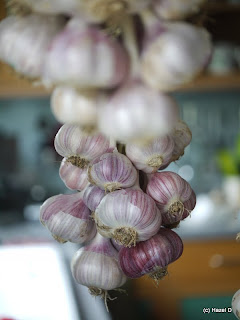Hive 1 inspection today. Last time we went into Hive1, just under a week ago, the bees weren't too happy, we couldn't find any eggs, and we suspected that they were Queenless. I came home, did some calculations to see when was the earliest/latest we should be seeing eggs and we knew that today was likely to be a tough day.
Over coffee, before we left home, we went through our plan. We've learned that it is better to discuss this before we get to the Bees, so that (a) we can talk through any disagreements without trying to do it surrounded by small buzzy insects, and (b) we both know who's doing what, what we're looking for, and we can work together as a team rather than having an argy bargy. As I now take a voice recorder to make my notes, instead of trying to memorise our observations, or to write them down, I definitely don't want to be listening to us snapping at each other!
Did the chooks first. Roo looks brighter, but still not right. No one is broody, for the first time in ages. Worming went really well, with everyone getting dosed once and and only once. Once that was all out of the way, we suited up and got started.
There are quite a lot of weeds growing up around the hives, so while DH was unstrapping hive 1, I trod down the weeds around hive 2. Roof off, we could see a few bees still cleqaring up the frame in the eke. Decided to leave it in there for now. Opened up the Supers, and looked at a couple of combs - none have been drawn out - so that's not a great sign. Lifted the supers off.
A reasonable number of bees, but not lots. Took off the Queen Excluder (which stops the Queen going up into the Supers and laying eggs there), and we had a lot of bees around. They were not happy. I didn't expect them to welcome our intrusion, but these ladies started attacking us straight away. We continued with the inspection, safe in our bee suits, and pulled out a frame from the middle. All stores, one cup where there bees had obviously been desperately trying to create a queen cell. Looked at another frame further back, still all stores.
We were now getting pinged. It's not a problem per se, as we were secure in our suits and gloves, but it was astrong indicator that the poor bees had no Queen. If they have no Queen, the pheremone that binds the hive together is lacking, and they need this pheremone to feel contented (For anyone who has been watching "V" on TV, it reminds me of when Anna gives the "V" Bliss). We put the hive back together, trod down some of the weeds, and walked back to the chickens escorted by a number of guard bees. It took a while before the guard bees left us alone, so I kept my bee suit on while we gave the chooks their corn and locked up.
I am normally petrified of anything sting-y. I'm a bit more tolerant of bees than I used to be, that I now how they work and how hard working they are. But when I have my bee suit on, I don't mind them. Obviously I don't like it when they are pinging and stinging, but I don't feel the need to run away screaming. When I think back to my original concerns about whether I would be able to cope, I'm really pleased about this.
Our plan of action is that we need to take a look in Hive 2 in the next day or 2, and try and establish whether we have a Queen in there or not. If we do, we will reunite the two hives into one. If we don't, then we will definitely need to obtain a Queen. There are a couple of fundamental questions. 1) Do we go for a live Queen, or do we go for a queen cell? A live Queen is probably the best option, as we won't then have to wait for her to hatch. We'll take advice on that. (2) As the temperament of the Queen determines the temperament of the whole hive, we need to work out where the best place is to get a new queen. It's not that they are difficult to come by, lots of places rear them.... it's getting one that we know is of good temper.
I'll do a bit of research today, so I at least know what are options are. And I'll be keeping everything crossed that we find evidence of a Queen in Hive 2.











